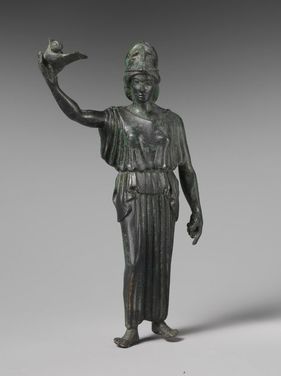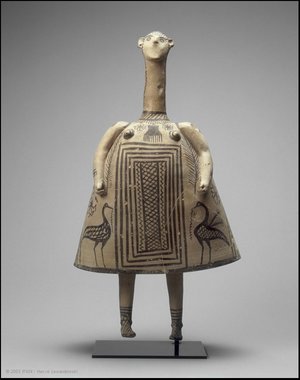|
When looking at the visual history of the Greek civilization there is a distinct shift in the portrayal of form, from the stylized roots of the Mycenaean and Minoan traditions to the naturalism which took hold during the Classical Era. This can be seen when comparing the terracotta figurine Bell Idol, created circa 700 BCE¹, to the later classical work Bronze Statuette of Athena Flying Her Owl (herein referred to as Bronze Athena) which dates back to circa 460 BCE². Set apart by both time and location, originating from Thebes (Boeotia) and Athens respectively, both sculptures work to illustrate the evolution of Greek canon. Yet by examining these two pieces, it becomes clear that despite their divergences and stylistic range, both the Bell Idol and Bronze Athena share similar aspects which are illustrative of Greek cultural values. Abstracted and stylistic, the Bell Idol is far from the popular image of Grecian sculpture. As a rare example of figurative sculpture from the late Geometric Era, the Bell Idol portrays elements from the Mycenaean and Minoan traditions³, linking them to the beginnings of the Archaic and Classical sculpture for which ancient Greece is so well known. Taking its name from the main form of the figure⁴, the Bell Idol was constructed by the Thebian workshop of the Oinochoe Group⁵ using traditional methods that date back to the 3rd millennium BCE⁶. The main body was created through the use of a potter's wheel while the anatomical additions of the elongated neck, head, arms and breasts were made with the pinch method and attached later⁷. The legs were created with the pinch method as well, but were never intended to be attached- instead they were originally made to swing loose⁸ from a string attached to the idol beneath her skirt⁹, much like a clapper in a bell. The painted lines which pattern the surface of the Bell Idol were added before firing¹⁰ using the black 'glaze' technique¹¹, similar to the other pottery of the era. Linear chevrons, interlocking triangles, swastikas, and designs of water fowl¹² cover the body of the Bell Idol, adding dimension and complexity to her more simplistic form. It is through these decorations that connections to the Geometric Period are found. The painted motifs were “closely linked to the late Geometric vases [constituting] the most solid foothold for the chronology of Boeotian bell-idols”¹³. The Geometric Period represented a turning point in Grecian society, acting as the bridge between the Dark Ages (ca. 900 to 700 BCE) and the end of the Mycenaean civilization, by way of Doric invasion, to the rise of Classical Greece¹⁴. The Geometric period saw the creation of the polis, the Greek alphabet, trade routes to the east and Greek colonies¹⁵ - essential elements which would serve as the building blocks to help to make Greece a cultural force which would echo for millennia to come. Stylistically, the Bell Idol fits into Geometric canon both in its construction and the geometric patterning which helped to distinguish the Geometric Period. At the other end of the spectrum, Bronze Athena provides an excellent example of the early Classical sculptural tradition. Created utilizing the cire perdue “lost wax” technique¹⁶ - an innovation essential to the start of the Classical period which allowed for greater detail¹⁷ - Bronze Athena finds the basis of its form in naturalism. Athena herself is proportionate in accordance to the classical canon and though slight stylization can be seen in the drape of her peplos, the fabric carries the weight to curve around her body in the “wet drapery” style. Upon her outstretched arm rests an owl, which in addition to her helmet, helps to identify her as Athena, the Greek goddess of wisdom¹⁸. Athena served as the patron goddess of Athens appearing in various incarnations such as Athena Polis (Athena of the City), Athena Eragane (Athena of Industry) and Athena Nike (Victory Athena)¹⁹. Athena's familiar, the owl, became almost synonymous with her presence, often occupying the Acropolis upon which her temples sat, if not the sanctuaries themselves²⁰. The association of both Athena and her owl was so prevalent in Athen's cultural identity, that by 438 BCE they even adorned Athenian currency²¹. Thus the action of flying her owl helps to solidify Bronze Athena's identity to the viewer. The Bronze Athena presents the goddess in a triumphant pose, with her face set in the severe style, emotionless yet projecting a sense of interiority. This method of bringing life to the work is one of the hallmarks of early Classical sculpture in Greece and, coupled with the implied motion of her movement, helps Bronze Athena allude to the heights that the Classical Era had yet to reach. When comparing these two sculptures, the different approaches to the representation of form are readily apparent. Bronze Athena, with Athena's fluid proportions and naturalism, highlights the ancient Greeks' increasing attention to detail and observance of life. In contrast, though she is figurative, the Bell Idol remains largely stylistic, much like the Mycenaean tradition which predates her. Though there is indications of natural form through the modeling of Bell Idol's nose, ears, hands, feet and breasts, they are for the most part abstracted and simplified. Instead, much of the detailing comes through the painted lines which decorate Bell Idol's surface- from the shapes of her eyes or the poikilia patterning of her hair to the geometric motifs and design elements which cover her dress. Conversely, the repeated pattern of the folds in the peplos of the Bronze Athena are fully shaped out by the artist, allowing the three dimensionality of the form to speak for itself. Though both sculptors worked to imbue a sense of motion within their pieces, their approaches varied greatly. The Bell Idol for all her stiffness, is essentially a kinetic sculpture with her dangling legs which allowed for actual movement should she be moved or subject to a breeze. Bronze Athena on the other hand, holds all the intention of motion but is physically static. The Classical artist used different conventions to create the appearance of motion, both through Athena's gesture and the utilization of counterpoise - another early Classical innovation of form - which highlighted the body through the contrasting flexing and relaxation of the muscles. This interplay helped to underscore the classical concept of rhythmos, which artists sought to imbue into their works, in order to portray a sense of movement, rhythm, and composition. Despite their stylistic differences, there are several similarities which present themselves within the Bell Idol and Bronze Athena. Both were constructed via additive methods, containing a sense of patterning, no matter how overt or subtle. Both contain references to wild life, through the crane decorations which adorn Bell Idol's skirt and Bronze Athena's owl tying them into the forces of nature. Most importantly, both sculptures seem to have had religious connections. The Bell Idol was believed to be associated with a nature goddess²², while Bronze Athena served as a personification of the Athenian goddess. These attributions help to give context to the roles both statues played within Greek society. According to the scholars at the Metropolitan Museum of Art, “Ancient Greek religious practice, essentially conservative in nature, was based on time-honored observances, many rooted in the Bronze Age (3000–1050 B.C.), or even earlier”²³. One such tradition was the use of votives, which were used as offerings to the gods in order to gain their favor. Though anything which might delight or entertain the gods could be considered a votive²³, often they took the form of the gods and goddesses they sought to curry favor from. Votives could be placed in sanctuaries or grave sites, but often were inclusive of everyday life as well. Thus the Bell Idol and Bronze Athena both fit into the role of votive, acting as a conduit and embodiment of the divine forces they saw at work in the world around them. Terracotta works such as the Bell Idol were most commonly found in grave sites of women and children, alluding to a funerary role, a plea for protection or a guide the afterlife. Whereas bronzes such as Bronze Athena have been found in both sanctuaries and homes through out Athens²⁵. Though originating from a later period (circa 3 CE), the free standing statuettes discovered at the Agora dig in Athens provide continuing evidence of the Greeks' utilization of small bronze votives²⁶, of which Bronze Athena may be a precursor. Despite their differing contexts, both sculptures worked to provide that link between the pious and the deities they worshiped. In addition, the smaller scale and lack of monumentality seen in both the Bell Idol and the Bronze Athena illustrate the importance of personal worship or dedication to the gods through their more intimate size. Thus the Bell Idol and Bronze Athena represent a range on the continuum of Greek artistic practice from the Bronze Age origins of the terracotta figurine to the stylistic innovations of the cire perdue bronze. The evolution from the Geometric Age to the Early Classical period becomes apparent through the comparison of the Bell Idol's stylized and abstracted form to Bronze Athena's naturalistic grace and fluidity, while the cultural heritage and context they both share help to unite them in a shared purpose. Together the Bell Idol and Bronze Athena illustrate the transformation and unique development of Greek culture as well as the strength of it's underlying social and religious structures. 1 Néguine, Mathieux. "Bell Idol." Louvre Collection: Bell Idol. Accessed October 22, 2016. http://www.louvre.fr/en/oeuvre-notices/bell-idol. 2 Department of Greek and Roman Art. "Bronze Statuette of Athena Flying Her Owl." The Met | Collection Records. Accessed October 22, 2016. http://www.metmuseum.org/art/collection/search/254648. 3 Néguine, Mathieux. “Bell Idol”. 4 Szabó, Miklós. Archaic Terracottas of Boeotia. Vol. #67. Roma: "L'Erma" Di Bretschneider, 1994. Print. Studia Archaeologica Series. 15. 5 Néguine, Mathieux. "Bell Idol." 6 Braun, Thomas, et al. "Greece, Ancient." Grove Art Online. Oxford Art Online. Oxford University Press, accessed October 22, 2016, http://0-www.oxfordartonline.com.library.academyart.edu/subscriber/article/grove/art/T034254pg9. 7 Néguine, Mathieux. “Bell Idol” 8 Négiuine, Mathieux. “Bell Idol” 9 Szabó, Miklós. Archaic Terracottas of the Boeotia. 15. 10 Szabó, Miklós. Archaic Terracottas of the Boeotia. 15. 11Braun, Thomas, et al. “Greece, Ancient” 12 Néguine, Mathieux. “Bell Idol”. 13 Szabó, Milós. Archaic Terracottas of the Boeotia. 17. 14 Department of Greek and Roman Art. "Geometric Art in Ancient Greece." The Heilbrunn Timeline of Art History. October 2014. Accessed October 22, 2016. http://metmuseum.org/toah/hd/grge/hd_grge.htm. 15 Dept. of Greek and Roman Art. “Geometric Art...” 16 Dept of Greek and Roman Art. "Bronze Statuette of Athena.." 17 Braun, Thomas, et al. “Greece, Ancient”. 18 Hemingway, Colette, and Séan Hemingway. "Greek Gods and Religious Practices." The Heilbrunn Timeline of Art History. October 2003. Accessed October 22, 2016. http://www.metmuseum.org/TOAH/HD/grlg/hd_grlg.htm. 19 Stewart, Andrew F. Classical Greece and the Birth of Western Art. Cambridge: Cambridge University Press, 2008. 151. 20 Dept. of Greek and Roman Art. “Bronze Statuette of Athena...” 21 Stewart, Andrew F. Classical Greece and the Birth of Western Art, 151. 22Néguine, Mathieux. “Bell Idol” 23 Hemingway, Colette and Séan Hemingway. “Greek Gods and Religious Practices”. 24 McC., H. "Greek Votive Offerings." The Metropolitan Museum of Art Bulletin 15, no. 2 (1920): 36-38, 36. 25 Braun, Thomas, et al. “Greece, Ancient”. 26 "Agora Excavations." ASCSA.net. Accessed October 22, 2016. http://agora.ascsa.net/research?v=default. Works Cited:
0 Comments
Leave a Reply. |
AuthorCrystal has a MA in the History of Art from Courtauld Institute of Art as well as a BFA in Art History from the Academy of Art University. Archives
November 2017
Categories
All
|




 RSS Feed
RSS Feed